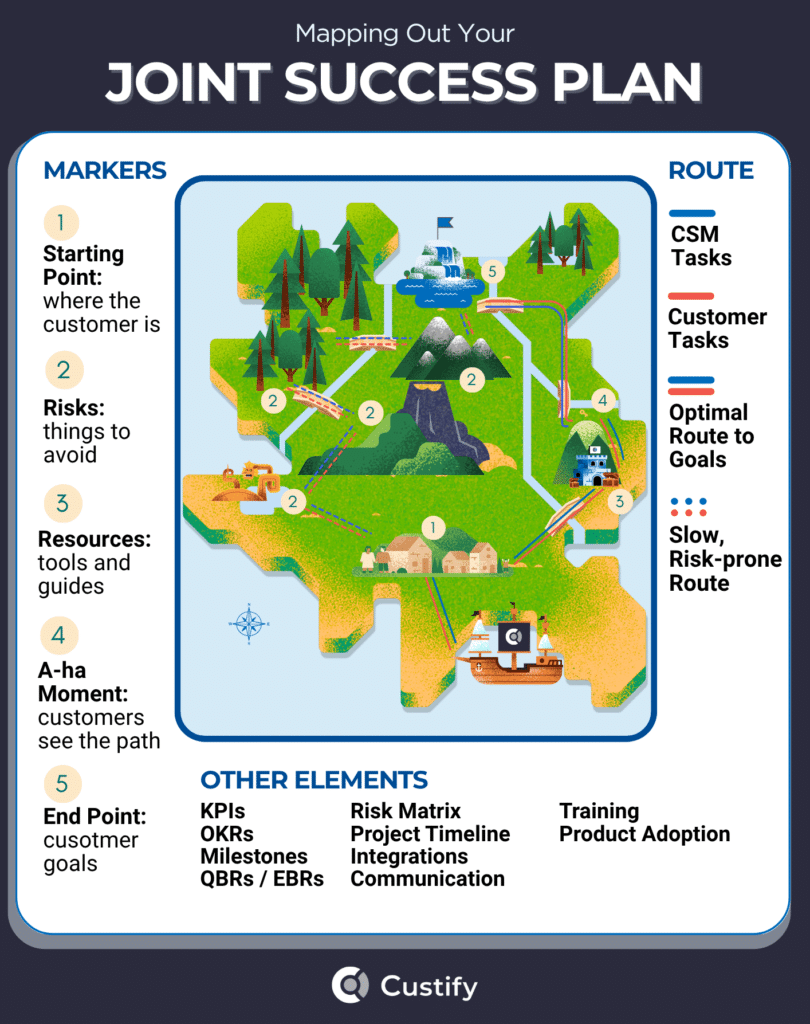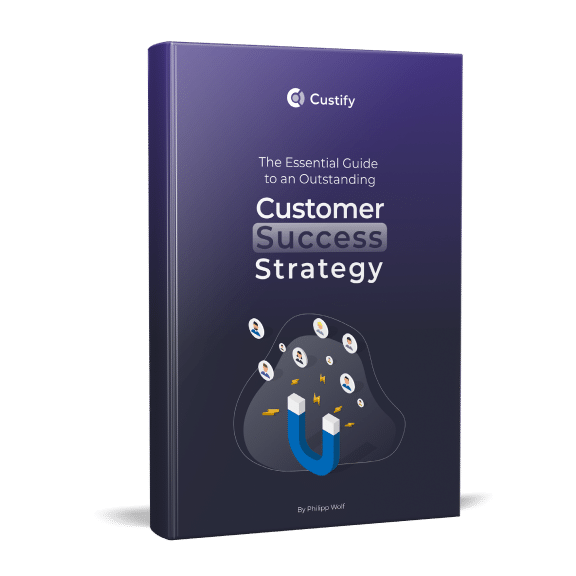Joint success plans are becoming more and more popular. But are they just another buzzword or something you can use?
Think of it like this – customer success thrives on collaboration.
You may have the best product in the world. A set of perfectly optimized services. And customers who understand and use both your product and services. But without a collaborative approach, it will all feel disjointed.
So today, I’ll explore:
- How to use a joint success plan to enable collaboration with your customers
- What joint success plans actually are, what they look like, and what goes into making one.
- The step-by-step process of making a mutual success plan, with practical advice and illustrations along the way.
What Is a Joint Success Plan?
A joint success plan, also known as a joint customer success plan or mutual plan, is a type of project plan shared between a customer and their assigned customer success or account manager. It represents an illustration of the customer’s goals, the resources and path to those goals, and what it takes to reach them.
Joint success plans help visualize the customer’s current situation in contrast to their destination. CSMs usually craft a joint success plan to present to the customer before following through and guiding that client through the journey, often helping them through QBRs, EBRs, and frequent check-ins, along with more concrete, specific help relating to tasks, integrations, and product requirements.
When Are Joint Success Plans Useful?
Joint customer success plans are generally useful for businesses with a high-touch engagement model. These businesses typically serve customers with complex business cases, extensive service-level or experience-level agreements, or enterprise customers that require a special level of care and support.
Keep in mind, however, that joint success plans imply significant effort from your team and therefore only make sense in these specific situations. If your clients aren’t willing to collaborate or open to your proposals, it’s better to skip the joint venture and look for other ways to help from a distance.
I’ve used Success Collaboration Sheets of various types with customers. These work if the customer takes and active interest in communicating their goals and asking for a plan to achieve them.
Almost never works when these are “pushed” onto customers.
– Manuel Harnisch, VP, Customer Success @ FOSSA
Key Benefits of Joint Success Plans for Customer Success
- Increased customer alignment. By putting customer goals front and center in your joint success plan, you’re setting a clear, customer-defined target for every team member who follows that plan. It’s one of the best ways to secure alignment and collaboration for customer success.
- Customer-first approach. A key tenet of customer success is to place the customer’s needs front and center. The point is to deliver value that can, in time, secure retention, improve loyalty, bring in referrals, and even grow the account.
- Optimized resource utilization. When you know where your customers are headed, you can better plan their journey to get there. That won’t just make their experience better, it will also help you be more efficient with your time and resources – planning, assigning, and using everything as needed.
- Better business outcomes. Joint success plans also enable your success as a business. If customers see the level of care you’re providing, they’ll be much more likely to write up a good review for you, tell their business connections, and maybe even try those new features you’re adding.
- Risk assessment. Few customers or projects warrant a full risk assessment matrix. However, they’re standard practice as part of a joint success plan. Risk matrices allow you to clearly identify potential roadblocks and make plans to mitigate them.
- Clear accountability models. Like any project plan, a joint success plan will have clearly defined roles, responsibilities, and owners for each stage of the project. They will have dependencies and clear contingencies for every major risk. Through this model, you’ll have a clear image of just who is in charge of what.
Mapping Out a Joint Success Plan – What’s Included?
The best way to visualize a joint customer success plan is by using a map.
To start, you’ll need to know all the important points on the mutual success map:
- Where you’re starting.
- Where you’re going.
- The resources a customer has at their disposal.
- The point where the customer sees the path to success.
- Risks and dangers you need to avoid.
You should then plan the best route you can take to those goals, as well as the path you want to avoid (so you recognize the signs).
These are the basics. To them, you add some common project management elements, such as:
- The resources at your disposal.
- A proposed timeline for execution.
- A set of communication practices and tools.
- A clear risk assessment matrix.
- A set of KPIs and methods to track them.
Lastly, some things to keep in mind as you’re mapping out your joint success plan:
- Both customers and CSMs share the responsibility of reaching customer goals.
- The route to your customers’ goals is a two-way street – you can also go backwards if you implement the wrong measures.
- To avoid going down a slower, more inefficient route, it’s often essential to stop and reevaluate your position – for example, by holding quarterly business reviews.
- If you accidentally go down the wrong route, both the customer and the lead CSM will suffer, as the amount of work will increase. Furthermore, you’re increasing the likelihood of churn, wasting all the resources and effort that went into the joint plan execution up to that point.

*Note that for this method, I combined tactics from Custify’s extensive knowledge base with several methodologies from Forrester, Salesforce, and other sources. Furthermore, the joint success plan model relies heavily on global project management standards developed by the Project Management Institute.
Key Steps to Building Outcome-Driven Joint Success Plans
Stage 1 – Putting Together the Plan Brief
The first stage is all about project alignment – understanding what you need to do, who is in charge of what, who needs visibility along the way, and the path you’ll be walking down towards your joint goals.
Identifying and Assigning Project Roles
Start by defining:
- A complete list of stakeholders – people from the customer’s side, and those from your team.
- A clear set of roles for everyone on the project – what the customer’s responsibilities are, what the lead CSM needs to do, and how the work will be tracked and evaluated.
Lastly, get everyone aligned on their role before moving forward. If it’s a small team – just you and the customer – it should be easier. But if it’s a larger project, you’ll need full commitment from everyone.
Communication and Planning Meetings
Next up is the communication plan – because you need to know how you’ll be checking in with everyone on the project along the way. Most importantly, you’ll want to set regular meetings with the customer representative.
The first few of these meetings will determine your project outlook – what your requirements are, what resources you have at your disposal, and how you’ll be making the most of them.
I found that most customers struggle to clearly define what success means for them. Also, who do you ask? If you ask the team which uses the product you will most likely get different success criteria than when you ask executives. I found having QBRs with executives present provides a good mix of how different personas define success. In my experience, the executive support is often needed, so a joint plan with their input and sign-off is important for achieving the outcome.
– Axel Schneider, Founder and Owner, Customer Success Services
Setting Goals and Objectives
The last part of the initial stage has to do with setting your objectives. Up to this point, you may have had some loose goals from your client – now is the time to set them in stone, make them SMART, and align everyone on those goals.
Stage 2 – Drafting a Project Plan
The second stage is where things come together. At this point, you’ve already gathered all the information – now it’s all about meeting with the customer and all other interested parties and getting to work writing the plan itself.
Work Groups and Check Ins
A lot of the time in customer success, the customer will appreciate and find value in regular work meetings. That’s because they often have responsibilities they can’t take care of themselves – either because they don’t have the technical know-how, time, or resources to do so.
That’s where a lead CSM steps in, particularly when drafting a joint success plan.
Think of yourself as the enabler in this case – the person who checks in with all stakeholders, centralizes all the information, and ensures implementation by delegating and meeting with the customer to help them fulfill their side of the tasks.
Writing Down the Plan
By the end of this process, you should have everything you need to write the plan. Map every component of your mutual plan using the map we provided earlier in the article.
Remember to make everything as clear as possible, keep customer goals front and center, and devise the most efficient route to those goals.
Collaborating on a Final Plan
Now that you have completed a draft of your plan, share it with stakeholders and set a meeting to agree on a final version. At this stage, you should highlight precisely what everyone’s final role and responsibilities are, and how their activity will be measured, along with any risks and contingencies needed.
Stage 3 – Executing and Optimizing the Plan
Lastly, it’s time for implementation. Once you have an approved joint success plan, you also have the play-by-play of what comes next. But your work on the plan doesn’t stop here – you should always keep an eye out for potential issues, improvements, and opportunities to improve.
Collecting Feedback
Once the plan is underway, start by collecting feedback from the customer – see how it’s going, track metrics and health scores (using your customer success software), talk to the customer, and quietly supervise how it’s going.
This step will allow you to look for opportunities to improve the process, but never to the detriment of actually following the joint success plan. Remember that if you find an improvement you can’t realistically implement without slowing down or stalling progress, it’s best to keep it in mind for your next mutual plan.
Monitoring KPIs and Health Scores
Besides looking for improvements, you should also be tracking the progress of your joint success plan. The KPIs and OKRs you set earlier will be key here, as will the methods you wrote down for tracking those.
The best thing to do is to set up a customer success dashboard where you can monitor every facet of your mutual plan. Then, all that’s left is to check how the project is going periodically – either through manual monitoring or automated signals.
Implementing Updates
Based on all of this information you’re collecting, see what you can improve in real time. Step in to tweak a document, course-correct the customer when they’re about to take the wrong step, and reach out to a colleague when something’s not going as planned. It’s all about the million different, small ways you are providing value to the customer, to the project, and in turn to your business.
This process will also hone your skills at crafting and following through with joint success plans in the future. It will make it so that you automatically adjust any future plans you draft. And that’s one of the key ways, in my opinion, to get better at doing mutual plans at scale.
CSM Perspective: The Two Key Elements of a Solid Success Plan
Finally, we had an extensive breakdown of how to make joint success plans effective from Parker Chase-Corwin, a leading voice in the CS space and frequent contributor to our blog:

CEO & Principal Consultant
Xperience Alchemy
Success Plans sound great in theory, but I think are often poorly executed. Lots to dig in on but here are a few high-level points:
I like to think of Success Plans less as a shared document (although that’s nice if both parties are willing) but more as a guided conversation to ensure you can ultimately answer one thing – what are the quantifiable measurements of success that your customer is looking to achieve with your product and what is standing in the way of that?
I think CS teams get bogged down in the template itself and the logistics of keeping them updated regularly. For this reason, simple is best. Try not to overwhelm it with redundant profile fields from your CRM or too many tactical execution details. You’re looking to align on measurements of success and capture them so you can keep tracking towards them.
Research shows that a customer who tracks progress towards their goals (even if they don’t hit them) is far more likely to stay with you than a customer who doesn’t. Success Plans give you that artifact to refer to (which is particularly useful when your primary contact leaves their post).
They need to be regularly updated, but should not be used as a project plan. Ideally, you have the decision maker’s perspective, complemented by the administrator’s. Part of your job is to ensure there is alignment amongst the stakeholders.
Ultimately, there are two tools a CSM needs to drive a solid Success Plan:
- First, an arsenal of good, leading, discovery questions to help get as much context and insight as possible to guide them on the right path.
- Second, are examples from your best customers on what they do, because – let’s be honest – not every customer we work with will know how to measurably define what success looks like. We need to be authorities on the subject and guide them using best practices that we have already gathered (while also keeping them realistic and achievable).
If, like me, you love how Parker approaches CS topics such as joint success plans, you might like to hear our interview with him as part of our podcast series, Mastering CS – Candid Leader Insights.
Crafting Perfect Joint Success Plans Starts Here
Whether you’re building a joint success plan for a single enterprise customer or applying the tactic to your entire customer base, you’ll need the proper tools to ensure you’re providing as much value as possible to your clients.
That’s where Custify comes in. With the power of our customer success platform, you can handle every step on the journey to building a successful mutual plan template that you can then deploy to any customer you want.
Not sure how to get started? Schedule a demo and we’ll walk you through the steps to your goals, just like you want to do for your customers. And don’t worry – setting a call doesn’t imply any sort of commitment. Our goal is and has always been to help people as much as possible – so let us help you too!




